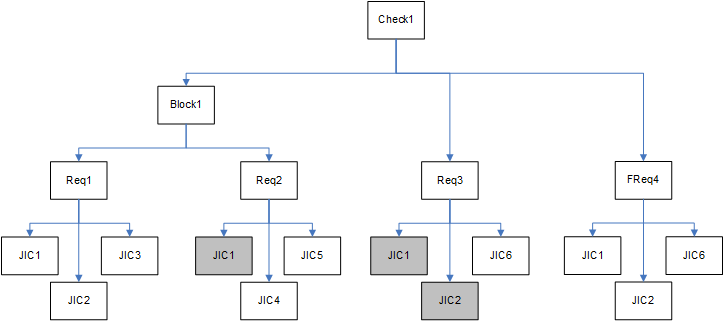Duplicate job card suppression
To avoid issuing duplicate tasks to technicians, Maintenix automatically suppresses most duplicate job cards.
Within a work package, it is possible to have multiple job cards that are based on the same task definition. However, during the execution of this work package, the work specified by the job card has to be performed only once. For example, a job card explaining how to perform some preliminary work (like removing a part to be able to access another component), should only be executed once for all of the requirements (other than follow-on requirements) in the work package.
- Duplicate job card suppression can be disabled.
- Duplicate job card suppression can be enabled for more complex replacement task workflows in which multiple replacement tasks (REPL class requirements) in the same work package share a common job card.
-
Detects whether the workscope contains more than one job card based on the same revision of the same job card definition.
-
When there are duplicates, Maintenix marks one of the duplicates as the to-be-executed job card, and suppresses the others by making them view-only copies. However, duplicate job cards based on follow-on requirements are not suppressed.
-
Cancels the part requests that exist for the suppressed duplicate job cards.
-
Adds a reference to each suppressed job card that identifies the to-be-executed job card. If you try to open the Task Details page of a suppressed job card, Maintenix opens the task details of the to-be executed job card. This ensures that the modifications users make to the task are applied to the one task that is in the workscope.
-
When you generate the workscope of a work package.
-
When you commit a work package.
-
When you assign tasks to a committed work package.
-
When a block is initialized; if the block contains duplicate subtasks, all but one are suppressed; therefore, no part requests are created for these suppressed job cards.
For example, when Block 1—shown in the following diagram—is initialized, one of the JIC1 instances is automatically suppressed. Part requests are not created for this job card. Block 1 is then assigned to work package Check 1, and Req 3 is also assigned to Check 1. In addition, a follow-on requirement called FReq 4 is also assigned to Check 1. When the workscope is generated, JIC1 and JIC2 are suppressed for Req2 and Req3, and their part requests are canceled. However, JIC1 and JIC2 are not suppressed for FolReq4.
Figure: Duplicate job card example

Maintenix reviews the job cards that were suppressed whenever you remove tasks from a committed work package, and when you add or remove part requirements from the to-be-executed job card that remains in the workscope. It also updates the information on the suppressed job cards when maintenance personnel complete the to-be-executed task in the work package. The following subsections provide details about these situations.
Duplicate tasks initiated from executable requirements
When duplicate suppression is enabled for job cards, some organizations configure Maintenix to exclude executable requirements from the task suppression logic. Most organizations want to suppress duplicate job cards when work packages are committed or started, but for compliance reasons, duplicate tasks created from executable requirements for the same component might be allowed. For example, multiple faults on the same component might have the same corrective subtask. Note that if duplicates are suppressed for job cards and executable requirements, duplicates of tasks with the FOLLOW task class are not suppressed. For configuration information, see the Maintenix Administration Guide.